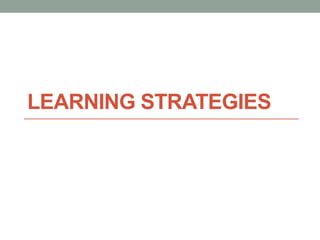
Learning strategies
- 2. LEARNING STRATEGIES Formulaic speech Creative speech
- 3. FORMULAIC SPEECH “expressions which are (1) learned as unanalysable wholes and (2) employed on particular occassions.” (Lyon 1986) (1) Learners may produce an utterance he learned, knowing its function without knowing its structure. (2) Learners use each formula for each particular communicative goal.
- 4. TYPES OF FORMULAIC SPEECH Routines Patterns Scripts Totally unalyzed Partially Rather fixed and unanalyzed predictable How do you do? Can I have a _____? You are welcome. E.g., Greeting There is no ______? I can’t speak sequences I wanna ______. English. (Krashen & Scarcella 1978) (Ellis 1984c)
- 5. STRATEGIES INVOLVED IN ACQUIRING FORMULAIC SPEECH PATTERN PATTERN PATTERN MEMORIZATION IMMITATION ANALYSIS Psycholinguistic Behavioural strategy strategy Cannot be Can be observed observed
- 6. PATTERN MEMORIZATION STORED INPUT (1) Patterns (2) Each pattern have to be has to be linked to highly a communicative frequent function Holistic processing is involved (Seliger 1982)
- 7. PATTERN IMMITATION Learners deliberately and methodically copy the whole utterance or part of it
- 8. PATTERN ANALYSIS FORMULA FORMULA segment segment segment segment Rule-bound ways of combination NEW STRUCTURE BASIS FOR THIS ANALYSIS: Comparing formulas and looking for similarities and differences
- 9. FORMULAIC SPEECH Common in early SLA Reduce the learning burden while maximizing communicative ability
- 10. STRATEGIES INVOLVED IN ACQUIRING CREATIVE SPEECH ESTABLISHING AUTOMATIZING INTERLANGUAGE INTERLANGUAGE RULES KNOWLEDGE (Faerch & Kasper 1980)
- 11. PROCESS OF ESTABLISHING INTERLANGUAGE RULES Overgeneralization SIMPLIFICATION Transfer HYPOTHESIS FORMATION Intralingual INFERENCING Extralingual RECEPTIVE PRODUCTIVE HYPOTHESIS TESTING METALINGUAL INTERACTIONAL
- 12. HYPOTHESIS FORMATION Hypotheses about interlanguage rules are formed in three ways: 1. Using prior linguistic knowledge 2. Inducing new rules from the input data 3. A combination of (1) and (2) Summary
- 13. SIMPLIFICATION “attempts by the leaners to control the range of hypotheses he attempts to build… by restricting hypothesis formation to those hypotheses which are relatively easy to form and will facilitate communication.” (Ellis 1985) Summary
- 14. SIMPLIFICATION STRATEGIES TRANSFER OVERGENERALIZATION Use L1 as a basis for Extend existing L2 knowledge forming hypotheses about L2 to new interlanguage forms E.g., overgeneralization of E.g., transfer of Vietnamese forming past form for word order into English irregular verbs
- 15. INFERENCING Learners attempt to “induce the rule from the input”. (Ellis 1985)
- 16. INFERENCING STRATEGIES INTRALINGUAL EXTRALINGUAL INFERENCING INFERENCING Build up hypotheses by Build up hypotheses by relying analyzing external L2 data on contextual meaning Summary
- 17. PROCESS OF ESTABLISHING INTERLANGUAGE RULES Overgeneralization SIMPLIFICATION Transfer HYPOTHESIS FORMATION Intralingual INFERENCING Extralingual RECEPTIVE PRODUCTIVE HYPOTHESIS TESTING METALINGUAL INTERACTIONAL
- 18. HYPOTHESIS TESTING Hypotheses can be tested out in a number of ways: 1. Receptively (comparing hypotheses with L2 data) 2. Productively (making utterances containing the hypothesized rules to check their correctness in terms of feedbacks) 3. Metalingually (consulting teachers, natives, dictionaries) 4. Interactionally (elicit a repair from interlocutor) (Faerch & Kasper 1983b) Creative speech
- 19. STRATEGIES INVOLVED IN ACQUIRING CREATIVE SPEECH ESTABLISHING AUTOMATIZING INTERLANGUAGE INTERLANGUAGE RULES KNOWLEDGE (Faerch & Kasper 1980)
- 20. AUTOMATIZATION Learners try to consolidate hypotheses about L2 by accumulating confirmatory evidence. (Ellis 1985)
- 21. AUTOMATIZATION STRATEGIES FORMAL FUNCTIONAL PRACTICE PRACTICE Focus is on Focus is on formal features of L2 communicative endeavour
- 22. REFERENCES Ellis, R. (1985). Understanding second language acquisition. Oxford: Oxford University Press Gebhardt, M. (2007). Learning strategies in first and second language acquisition. Verlag: GRIN Verlag Ellis, R. (2012). Language Teaching Research and Language Pedagogy. Hoboken: Wiley- Blackwell.